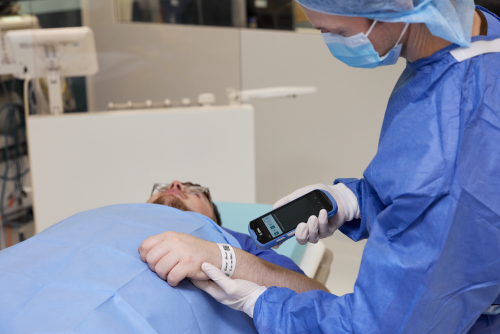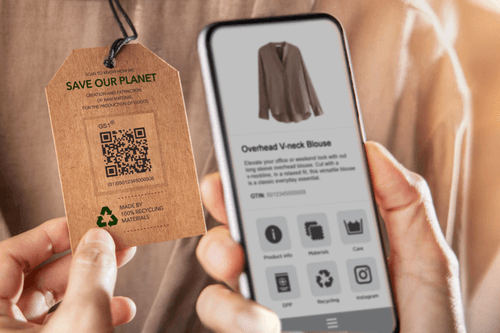A summary of the highlights and key takeaways from GS1 UK's partner event at The Gherkin, London, on Monday 24 June 2024.
On behalf of GS1 UK, I would like to extend our heartfelt thanks to everyone who joined us for this year's partner event. It was an energising day filled with insightful sessions and engaging discussions, bringing together industry leaders and experts to explore the future of GS1 standards across healthcare, construction, and retail.
The event provided a platform for meaningful exchanges, and we hope it left attendees with a clear understanding of the role and importance of partners within GS1 UK's strategic vision for the next three years.
Anish Tailor, head of partnerships, GS1 UK
Session recap
A brief overview of the sessions and key takeaways from the day's sessions. Read up on the top themes and explore forthcoming opportunities for partners.

GS1 and the power of networks
The day kicked off with a keynote speech from GS1 UK’s CEO, Anne Godfrey, who provided an overview of GS1 UK’s strategy and ambitions for the next three years. Anne highlighted the drivers of relevance that influenced GS1 UK’s strategic direction, including a demand for trusted data, informed protected consumers, digital evolution, an evolving political landscape and supply chain traceability.
Anne also introduced QR codes powered by GS1 and outlined several use cases, including traceability, waste reduction, point of sale, authentication, inventory management, and sustainability and recycling among others. Anne stressed the power of partnerships as part of the strategy, to help shape the future and successfully deliver standards in action.
Anne Godfrey, CEO, GS1 UK

A UK approach to Scan4Safety adoption
Glen opened the healthcare section with an announcement on some major developments within the industry. He reinforced GS1’s global strategy to continue to drive the adoption of the 2D DataMatrix for all regulated healthcare products - including a global initiative to allow native scanning of the GS1 2D DataMatrix using Google and Apple devices.
Glen went on to update the audience on the national Scan4Safety programmes in all four nations. He explained: "We are seeing fantastic growth for the use of standards across the UK healthcare system. More than 50% of trusts now have inventory management systems and scanning at the point of care, which in turn presents brilliant opportunities for partners to support hospitals with their adoption".
Glen also announced the return of the healthcare conference which has been confirmed for 29 and 30 April, 2025. The event will return to London's QEII Centre and will be supported by event partners, BiP Solutions.
If you would like to register your interest to be first to hear about sponsorship and exhibition opportunities, please complete the short form below and we will let you know as soon as the packages are available for bookings.
GS1 standards in action in healthcare
We invited three fantastic NHS guest speakers to the stage to showcase GS1 standards in action.
- The art of the possible: exploring new applications for Scan4Safety
Mark Songhurst, Scan4Safety programme manager, Leeds Teaching Hospitals NHS Trust
- MFT’s story: Scan4Safety and GS1 standards in section
Debbie Stevenson, head of supplies and purchase to pay, Manchester University Hospital NHS Foundation Trust
- Implementing GS1 standards across an ICS, our journey so far
Edd James MBE FCIPS, director of procurement, Humber and North Yorkshire Procurement Collaborative
Mark, Debbie and Edd explored the challenges faced within their trust or across their integrated care system. They demonstrated how the adoption of GS1 standards has helped improve patient safety and efficiencies, saving significant time and money.

Mark shared a new use case scanning Global Location numbers (GLNs) and the Global Service Relation Number (GSRN) at Leeds Teaching Hospitals NHS Trust to provide them with Live Bed State information.
Debbie spoke about the benefits shown from the data provided by their inventory management process and the integration of their inventory management system with their electronic patient record (EPR).
Edd is delivering Scan4Safety through the introduction of an IMS, which will ensure that the capture and use of the GSRN, GTIN, GLN and the Global Individual Asset Identifier (GIAI).
Panel: Critical success factors for implementation in healthcare
The panel, chaired by George, emphasised the collaborative efforts required to drive momentum in healthcare. Key points included the significance of engagement with users, especially clinical, the importance of accurate data by implementing standards and sharing data across systems and the importance of solution providers being on the journey with the trusts.
George Lawton, senior engagement manager - healthcare, GS1 UK
Navigating the ever-changing regulatory landscape
With the election around the corner, it’s no surprise that Iain shared insights into how this may impact the UK in terms of barriers to trade, and how this could create huge opportunities for GS1 UK partners implementing GS1 standards.

Iain touched on regulatory drivers playing a significant role in the application of GS1 standards across industry, as consumers seek greater accountability and much of the world look to accelerate their environmental policies.
A prime example of this can be seen in the upcoming Digital Product Passport (DPP), which is part of the EU Green deal, a set of policy initiatives by the European Commission that sets out ambitions for the European Union to be climate neutral by 2050. Since it is fast approaching and will impact all businesses trading into the EU, Iain once again stressed the importance of partners to delivering GS1 standards in industry.
Iain Walker, director of industry engagement, GS1 UK

GS1 UK’s new strategic priorities and the role of partners
We heard from GS1 UK’s chair and non-executive director of DEFRA (Department for Environment, Food & Rural Affairs) on the vital role of partners to successfully deliver GS1’s global transition to the 2D barcode, specifically QR codes powered by GS1. Chris referred to the introduction of the 1D barcode 50 years ago and the substantial opposition it faced then - an important message to consider today as we are confronted again with challenges, opposition and a long road ahead. However, he stressed the importance of remembering, without question, that 2D is the future and will become the new norm.
Chris Tyas OBE, chair, GS1 UK
A to Z story: what can construction learn from the tech industry?
We began the construction sessions with an industry guest speaker, CEO of Paperless construction of Raymond Castelyn. Raymond shared his thoughts on how the construction industry should learn from Amazon’s digital transformation. Quite simply, Amazon’s one click order process is fast, flexible, affordable, enables traceability and is repeatable.

The 2022 Building Safety Act outlines the need for a Golden Thread of Information, which refers to the use of unique identifiers to ensure full traceability of every element in a project, from design through to maintenance.
Therefore, much like the digitalisation of Amazon, the benefits of digital traceability in construction will improve handover and maintenance through the unique identification of all elements and simplifies the process for sourcing replacement parts and instantly accessing warranty and maintenance information. It also improves sustainability through cost reductions, more efficient resource management, waste reduction and the contribution to net zero.
Raymond Castelyn, CEO, Paperless Construction
Why you should be thinking about construction
GS1 UK’s head of construction, Shervin, supported Raymond’s vision by highlighting the need for consistent data given the complex environment of stakeholders, such as Contractors, architects, manufacturers and regulators.

The digitalisation of construction is one of the fastest growing industries globally, even faster than manufacturing, which is a direct result of the growing momentum for enhanced safety, digital transformation, sustainability and circularity.
Given the accelerating change, trusted data is more important than ever so it’s vital that industry comes together and find ways to work across boundaries. As such, Shervin’s goals to unlock GS1 standards in construction include segmenting the construction market to better focus on the value proposition for each segment and ensuring current construction members widen their application of standards in industry. A construction user group was also set up a year ago to collectively unpack how to fix industry challenges.
Shervin Yousefzadeh, head of construction, GS1 UK
Accelerating the transition to the next generation of barcodes
Camilla kicked off the section on QR codes powered by GS1 by highlighting the world of possibilities that they open up.

We are yet to discover many of the use cases, but some notable ones include; an enhanced consumer experience and access to additional information, reduced food waste, enabling the circular economy, safer and more efficient product recalls and ensuring information is accessible to all consumers.
Camilla emphasised the valuable role of partners in turning QR codes powered by GS1 into reality ready for sunrise 2027, when all retailers globally will be able to scan them at point of sale.
Partners have the knowledge, experience and capabilities to help create this new reality, but we need their support to drive awareness, facilitate collaboration, and demonstrate the art of the possible through live use cases.
Camilla Young, programme lead - QR codes powered by GS1, GS1 UK
How to scale up your connected packaging. Who are you forgetting?
We welcomed Marc from retail giant Unilever to the stage, alongside Mark from CEC, Unilever’s global connected pack specialist. They discussed Unilever’s mission to make their packaging fully accessible for far sighted, blind and partially sighted consumers through adopting accessible QR codes (AQR). When accessed via specialist apps, these AQRs can be scanned from a further distance and dictate critical labelling information, such as allergens and usage instructions.

Marc and Mark stressed the need to ensure no consumer is left behind as we transition to the new generation of barcodes by enabling accessibility by design.
Unilever currently has AQR, powered by GS1 standards, applied to 18 brands on 250 million items and counting. It may seem like a substantial task, but applying it to packaging with upcoming redesigns, or seasonal changes, and working with partners to guide you through the end-to-end process simplifies the process and ensures the future is accessible to all.
Marc Powell, global accessibility centre of excellence lead, Unilever
Mark Hewitt, global connected packaging specialist, CEC
The future of 2D in retail, through the lens of the UK’s biggest grocer
Tesco's development and transformation director, Matt Rhind, shared Tesco’s plans explore the potential of QR codes powered by GS1 using a three-pronged approach. He explained how Tesco are already speaking with suppliers on selected categories and emphasised the importance of working in partnership with suppliers, solution partners and GS1 as they begin to navigate this.

Matt highlighted the value of QR codes powered by GS1 to retailers such as Tesco:
- High data capacity - since QR can store several hundred elements including best before date, batch code, country of origin and supplier name
- Store process simplification - the ability to extract more data from a simple scan has the potential to significantly increase efficiency and simplify store process
- Improved traceability - QR can automatically capture important product info which can improve supply chain visibility, customer engagement and waste reduction
Matthew Rhind, development and transformation director, Tesco
QR panel: A world of possibilities with QR codes powered by GS1
Alongside speakers, Chris Tyas OBE, Mark Hewitt, and Matthew Rhind, Camilla Young chaired a panel discussion on the transition to QR codes powered by GS1.
The discussions covered the strategic implementation of connected packaging, and the challenges and opportunities that we are likely to experience.
